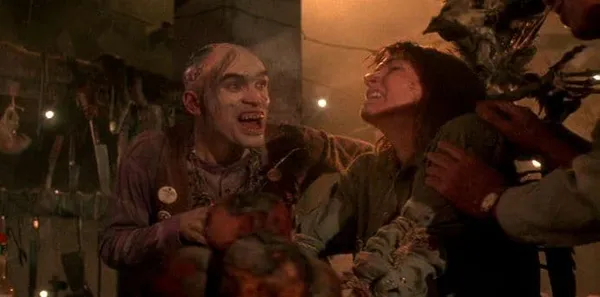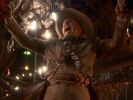Eye For Film >> Movies >> The Texas Chainsaw Massacre 2 (1986) Film Review

The Texas Chain Saw Massacre is arguably the most important – and greatest - horror film of the 1970s, but writer/director Tobe Hooper eventually suffered probably the most dramatic career decline of all his contemporaries, with Dario Argento, George A Romero and Brian De Palma still managing to intermittently shine a few years beyond his mid Eighties meltdown. Following the controversy surrounding Poltergeist – where rumours spread of Spielberg seizing the reins due to Hooper’s drug-addled incompetence – and a lengthy dry spell, the director threw himself into a big-money three-picture deal with Cannon, resulting in the bonkers sci-fi epic Lifeforce, a kid-flick reimagining of Fifties classic Invaders From Mars and the belated splat-stick sequel Texas Chainsaw Massacre 2. This flurry of activity was the nail in Hooper’s commercial prospect coffin, but each film has developed a devoted fan-base despite the shrinking budgets, reduced schedules and script-doctoring duress the studio put him under.
TCM2 is intentionally about as far from its predecessor as Hooper could get, amping up its under-appreciated black comedy and underlying satire to audience-baiting extremes, representing a sequel as self-reflexive as the similarly OTT Evil Dead 2 (Sam Raimi was definitely paying attention) and even Tom Six’s 4th Human Centipede 2 as well as pointing the way to Peter Jackson’s grot epics Bad Taste and Braindead. With demented turns from pre-Blue Velvet Dennis Hopper and a nails-on-chalkboard Bill Moseley as well as a standout return shift from creepily amusing original ‘Cook’ Jim Siedow, it’s a sickly stew that doesn’t always stick but there’s plenty of inimitable madness to savour and it represents a suitable bookend for Hooper’s initial gonzo period.

Late night Texas DJ Stretch feels stuck in her dead-end job when a prank call from some rich punks escalates into a crime that she happens to have recorded. Her detective work crosses paths with obsessive Texas Ranger Lefty Enright, who’s doggedly pursuing the killers of his nephew Franklin 13 years previously in the infamous massacre of which his niece Sally was the sole survivor. Meanwhile, Drayton Sawyer has become a local celebrity thanks to his award-winning chilli, but his rolling grill business is constantly threatened by financial burden and his wayward family of psychos, including ’Nam-traumatised Chop-Top and chainsaw-wielding man-child ‘Bubba’ Leatherface. Lefty eventually tracks them all to a disused theme park where the down-home family have captured Stretch, the only thing keeping her from becoming their next barbeque being Bubba’s affection.
TCM was something of a covert attack on both the flower-power generation and the society they spawned, coursing with a disillusionment that’s even more pronounced in the Reagan-era sequel. Where the cannibal clan seemed comfortably – defiantly even - set in their post-industrial redundancy ways before, they’re now both hungry for ever more meat and therefore money while railing against the government that makes their lives an uphill struggle, symbolizing the worst excesses of the Eighties as well as attacking the system that fed them. The same is true of the film itself: the garishly lit, blood-drenched action onscreen is grotesquely removed from Hooper’s dry cinema verite style and even drier emphasis on suggestion of yore, while LM Kit Carson’s scathing, scattershot script veers from Tex Avery lunacy to fierce indictment at every turn.
Technically, it’s a mixed bag of period affectations: Hooper’s direction is as slick as it is flat, lacking the serendipitous edge the low budget gave him before, while the blaring synth score is another Eighties hangover that’s a poor replacement for his teeth- gnashingly tumultuous musique concrete in the original. The impressive baroque set design also clashes with cluttered mise-en-scene that pales in comparison to Robert A Burns’ previous efforts, with the same bone-art props scattered about a fairy-lit subterranean netherworld that’s frustratingly over-bright and devoid of menace.
There’s still plenty of bite to Hooper’s sequel though, with several uncomfortably prolonged sequences that play on the vogue-ish women-in-peril tactics of Eighties slashers, often leading to moments of genuine fright or tension-puncturing mirth. One particularly unforgettable scene sees the no-longer cross-dressing but increasingly emasculated Leatherface seduced by Caroline Williams’ jean-shorts-sporting Stretch, the ’saw becoming the phallic extension that these maniacs’ tools always seemed to be in an overt display of impotent threat. Dry-humping her (and it) through a dysfunctional shaft, Hooper milks his horrific metaphor through to his villain’s premature ejaculation, the frustration of which sends him into a fit of rage that recalls The Funhouse’s similarly sympathetic and repressed bogeyman. From here a queasy romance develops that’s quirkily disturbing but also robs Leatherface of his power, leaving his brothers to hog the limelight.
And boy do they ever, ‘hog’ being perhaps the most prevalent word in the increasingly hare-brained Southern-fried dialogue. Bill Moseley’s Chop-Top has to be one of the most excruciating horror characters of all time, and this is undoubtedly deliberate: whether or not you go along with it, his unhinged mania represents an apt repeat attack on both faded hippy-dom and the Vietnam fetishism that was all the rage at the time (‘It’s what the people want – ’Nam-land!’). Meanwhile, the ‘greed is good’ mentality of the Gordon Gekko era is perfectly summed up by would-be entrepeneur Drayton’s summary of his ‘dog-eat-dog world’: ‘there just ain’t enough damn dogs!’ Jim Siedow is an absolute joy in this reprised role, lacing his bitter diatribes with ornery charm, his values proving just as absurdly twisted as they were in the original.
Bill Johnson plays Leatherface as a wide-eyed innocent, his goofy thrashing and adolescent lust positing him as a caricature of the teen angst that John Hughes pedalled (a notion reinforced by the theatrical poster’s homage to The Breakfast Club, with the clan humorously emulating the iconic poses of Ringwald et al). This may seem disappointing post-Gunnar Hansen, but it makes evolutionary sense; if Leatherface was a child before, playing with Sally like a doll, his teenage-style attraction to Stretch is understandable. His climactic duel with Lefty has to be seen to be believed, spoofing Star Wars’s light-saber battles with Hopper juggling three holstered chainsaws!
The veteran thesp – himself by then a Sixties-comedown relic – gives good gurn as the sanctimonious lawman, signposting his show-stopping Frank from the subsequent Blue Velvet: just check out his insane and hilarious chainsaw-shopping scene for evidence of his commitment to such nutso material. Caroline Williams makes for a likably flinty heroine, but unfortunately she’s reduced to a damsel-in-distress for much of the second half, replaying familiar scenes from the original in unflattering form. Lou Perryman makes a sweet foil for her, his bumbling lovelorn hick leavening the first half with many memorable touches: his fry-house (literally a house made out of fries) is especially heart-warming.
Special mention should go to Tom Savini’s pioneering effects work, which manages to be as disgusting as you’d expect without tipping the action into a realm of realism that might jeopardise its comedic goals. Kit Carson’s script also deserves credit: not all of it works, no doubt due to the time constraints and constant rewrites enforced by the studio, but there are so many venomous satirical barbs and sly little flourishes that the film warrants repeat views in spite of its myriad flaws.
While Hooper doesn’t hit the bulls-eye with all of his aims, he should be applauded for so wilfully refusing to repeat himself. TCM2 was never going to match its predecessor’s intensity but it does achieve a debauched delirium all of its own, and it’s aged better than its initial reception would indicate, having influenced so many horror-comedies since. Hooper’s films were always political – from Poltergeist’s real estate condemnation to The Mangler’s skewering of working conditions for the lower class – but this is absolutely his most brazen and angered piece. As Hooper’s critical re-evaluation continues, this represents his last real cinematic frontier, a wildly patchy but prickly missive from one of the genre’s true heroes.
Reviewed on: 12 Nov 2013


















